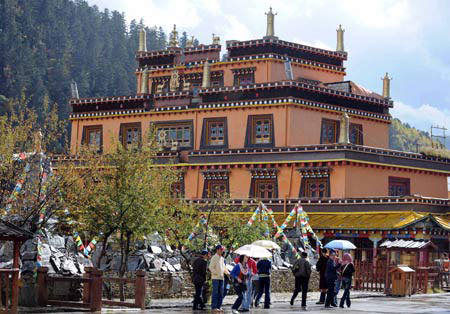Shangri-La, capital of the Tibetan autonomous prefecture of Diqing in southwest China's Yunnan Province, has long been called "sun and moon in heart" for its snow-capped mountains, luminous lakes, broad pastures and diverse flora and fauna.
 |
|
Tourists visit a monastery of the Tibetan Buddhism in the Potatso National Park in Shangri-La, southwest China's Yunnan Province, October 13, 2008.
|
In recent years, an increasing number of foreigners have been attracted to Shangri-La and other Tibetan areas in southwest China.
"What I saw here is quite different from what the Western media reported," said Mark Hiew, an Australian freelance writer, who visited a number of monasteries in Tibetan regions in 2007.
Hiew visited Labrang Monastery in Gansu, Langmu Monastery in Sichuan and Taer Monastery in Qinghai.
"I watched monks chanting and local people coming to pray. They wore traditional clothes, prayed and visited temples seemingly of their own free will. Although I do not understand their language, I was moved by the atmosphere," he said.
"And some of the younger monks were happy to speak a little English with me. I found them to be nice people. They invited me to their homes for butter tea. I was surprised by how much time they seemed to spend on their mobile phones," he said.
"Naturally, part of the interest as a foreigner is our idealized images of Tibet, but also all that we hear about Chinese government repression of the people," he added.
"When I was there, I was free to visit monasteries and local areas, and it didn't look to me like they were being outwardly oppressed at all. I saw stupas and prayer flags everywhere, " he said.
Such a response is common from foreigners who have actually experienced life in the Tibetan areas.
Gavin Maccloskey, from Northern Ireland, has been living in Chengdu, the capital of southwest China's Sichuan Province, which neighbors Tibet, for almost three years.
"The colorful nature of Tibetan life -- the art, especially thangkas and murals -- monasteries and faces of the people attracted me the most," said Maccloskey, who teaches at a language school in Chengdu and plans to start a thangka business with a friend in the United Kingdom.
A thangka is a painted or embroidered Buddhist banner, which is often hung in a monastery or over a family altar. It is occasionally carried by monks in ceremonial processions.
An Australian-born Chinese woman, Sze-en Lau, 23, became a volunteer in the Siguniang Mountain National Forest Park in Aba Tibetan-Qiang Autonomous Prefecture, Sichuan, at the beginning of 2008, right after graduating from the University of New South Wales.
"I teach the villagers environment protection," she said. "And most of time we work together in the wild."
She goes to the nearest town, Rilong, once a week to shop. The rest of her time, she lives in the mountain with the local Tibetans, drinks butter tea and eats a Tibetan dish known as tsamba, which is made of barley flour.
"I'm fine with the life here, sometime I do miss Tim Tam," a popular Australian biscuit, she said.
In the cold winter, she had to dance in her room to keep warm. Even after the May 12 earthquake, she remained in the mountain, not far from the epicenter.
Seadna Buke, a 24-year-old English teacher from Ireland who teaches in Chengdu, was impressed by the unique Tibetan culture.
"I feel the larger towns are becoming increasingly homogenized relative to the rest of China, but the countryside still has a very distinctive character," he said.
"Obviously a lot of Han Chinese now live in the Tibetan area, but it's hard to say whether that is something that pushes Tibetans to assimilate, or something that makes them take even greater pride in their own culture," he said.
"I would say that a good part of what is often attributed to assimilation is probably more fairly attributed to the effects of globalization," he said.
"On the whole, it seemed like they were doing fine, even if they are still obviously much poorer than urban Chinese. But I believe it's just a matter of time," he added.
A broad range of young foreigners have settled down in Chengdu, which they chose for a common reason: it's the nearest large, modern city to the Tibetan areas. The province's Ganzi and Aba Tibetan autonomous prefectures border Tibet, Qinghai, Gansu and Yunnan, where most Tibetans live.
"As long as I have money, I can get on the road any time," said Frances Nicol, a 23-year-old woman from the United Kingdom.
Pae Jeongwon, a devout Christian from the Republic of Korea, chose to take the train from Xining to Lhasa in February.
"I got a lot of inspiration for a book on the way," she said. Fifty years ago, those who wanted to go to Lhasa from Xining had to spend two months riding camels. Nowadays they only need 25 hours by rail.
Michael Leahey, a yoga instructor from Hawaii, flew from Chengdu to Lhasa, where he transferred to Katmandu last summer.
"When my plane flew over Mount Qomolangma, I was so excited I couldn't breathe," he said.
With the booming tourism industry and convenient traffic, Tibetan areas are on the itinerary of many foreign tourists. "The Tibetan areas are no longer the legendary inaccessible secret lands," said Leahey.